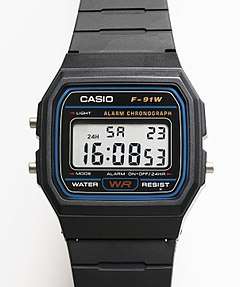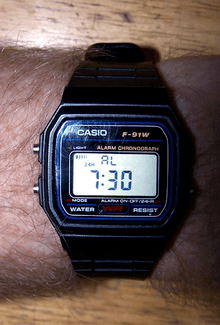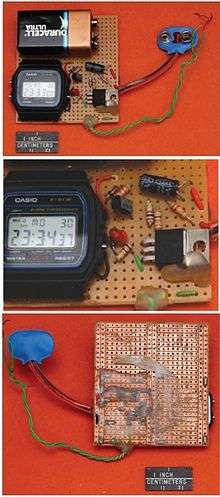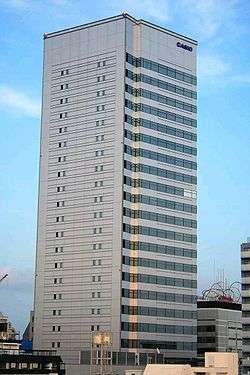Casio F-91W
 Casio F-91W-1 watch with a plastic case and resin strap | |
| Manufacturer | Casio |
|---|---|
| Type | Quartz |
| Display | Digital |
| Introduced | 1991[1] |
The Casio F-91W is a quartz digital watch manufactured by Japanese electronics company Casio. The original F-91W was introduced in 1991[2] and is still in production.[1] It is popular for its simplicity, reliability, and unpretentious clean design. Its design has not changed since it was first released 27 years ago.[1] The watch is available in several variants as part of the Casio F-series of watches. Casio does not release sales figures for the model but admits it continues to sell "well".[1]
Specifications
The F-91W has a 1⁄100 second stopwatch with a count up to 59:59.99 (nearly one hour). Marking net and split time (lap) is also featured. There are the options of an hourly time beep and a single daily alarm lasting 20 seconds. It has an automatic calendar, although auto-adjustment for leap years is not supported, as the watch does not record the year. February is always counted as 28 days.[3] The watch uses a faint, green LED light located to the left of the display for illumination (in earlier versions it was an amber microlight). The watch is reported to be accurate to ±30 seconds per month by Casio.[3]
The watch is powered by a single CR2016 3-volt lithium button cell, which lasts at least seven years, assuming 20 seconds of alarm and one second of light usage per day. However, these are seldom used in practice, so it is not uncommon for the battery to last 10 years or longer.
The watch case measures 37.5 by 33.5 by 8.5 millimetres (1.48 by 1.32 by 0.33 in) and weighs 21 grams (0.74 oz). The manufacturer's module number for this model (stamped on the stainless steel rear of the watch case) is 593. The strap is 18mm at the fitting and 22mm across the widest part of the lugs.
Water resistance
The watch has a reliable rubber seal between its steel back and case, but does not have any seals for its buttons. Since they fit tight enough, surface tension prevents the water from getting inside, but only to a certain point of water pressure. Therefore, the watch front is marked WATER RESIST,[3] but Casio reports different values for different variants of the watch. The black version (F91W-1)[4] is "30 meter / 3 bar", the ISO standard meaning of which is: "Suitable for everyday use. Splash/rain resistant. NOT suitable for showering, bathing, swimming, snorkeling, water related work and fishing", but the colored versions (e.g. F-91WC-2AEF) are "DIN 8310 / ISO 2281 – resistant to minor splashing". Even though the black version will resist an occasional water submersion if the buttons are not pressed, the watch should not be used in such conditions on a regular basis.
Durability
The watch is known to be very durable, people have bought the watch to use in a variety of situations: such as outdoors activities, working as a mechanic, doing construction jobs, or as a soldier. The body of the watch is known for lasting longer than the 10 year battery life. The watch will usually outlast the plastic strap that it comes with. Casio replacement straps are typically about the same price as a new F91W watch, however there are also replacement straps from other sellers available, usually at a fraction of the cost of the original ones. It's also common to buy a cheap lookalike and use that strap.
Operation

The watch is controlled by three side-mounted push-buttons. The upper left button turns on the light, cancels the alarm, resets the stopwatch or marks the split (lap) time, and is used for selecting settings. The lower left button cycles the modes of the watch: time display, alarm, stopwatch, and time/date adjustment. The button on the right is the function button: when used it starts and stops the stopwatch, changes the settings currently being adjusted, or switches between the 12- and 24-hour modes, depending on what mode the watch is currently in. Pressing all three buttons at the same time will fill all the cells on the LCD until any button is pressed again.[5]
The time or date is adjusted by pressing the lower left button three times to bring the watch to time adjustment mode. The top left button is used to cycle through seconds, hours, minutes, month, date, day, and normal mode. The right button is used to adjust the flashing value displayed. Unlike any other value, the seconds can only be zeroed. Should this happen before :30 seconds, the watch will zero in at the beginning of the current minute. After 30 seconds it will start the next minute as displayed. When the adjustments are finished, the bottom left button can be pressed once to return the watch to normal mode.
The watch display shows the day of the week, day of the month, hour, minute, seconds, and the signs PM in the afternoon – or 24H (24-hour clock) – at all times, the alarm signal status (bar of lines), and the hourly signal status (double beep on the hour, shown as a bell).
In stopwatch mode, minutes, seconds, and hundredths of a second are shown.
Usage in terrorism

According to secret documents issued to interrogators at Guantanamo Bay, obtained[6] and released by The Guardian, "the Casio F-91W digital watch was declared to be 'the sign of al-Qaeda' and a contributing factor to continued detention of prisoners by the analysts stationed at Guantanamo Bay. Briefing documents used to train staff in assessing the threat level of new detainees advise that possession of the F-91W – available online for as little as £4 – suggests the wearer has been trained in bomb making by al-Qaeda in Afghanistan."[7] United States Military intelligence officials have identified the F-91W as a watch that terrorists use when constructing time bombs.[8][9][10][11][12]
This association was highlighted in the Denbeaux study, and may have been used in some cases at the Guantanamo Bay detention camp.[13] An article published in the Washington Post in 1996 reported that Abdul Hakim Murad, Wali Khan Amin Shah, and Ramzi Ahmed Yousef had developed techniques to use commonly available Casio digital watches to detonate time bombs.[14]
Variants
| Model name | Description |
|---|---|
| F-91-WC | Neon colors: orange, blue, green, pink, beige and yellow [15] |
| F-91-WM | Metallic colored cases |
| F-94W | Different icon arrangement in the display |
| W59 | Waterproof up to 50m |
| A158W, A159W, A163W, A164W | Stainless steel band |
| A159WGA-1 | Stainless steel band, gold color |
| F-105W, A168W, A168WG-9 | Equipped with electroluminescent backlighting instead of LED in black resin, silver or gold |
| LA680 | Ladies' version |
Reception
The watch is worn all over the world. Its good design, high durability, low price and user friendly simplicity all contribute to this phenomenon. It is a "modest masterpiece" says design critic Stephen Bayley.[1] Counterfeits, which are quite common although the price tag of the original is very low, generally have a slightly lower plastic build quality, the LCD viewing angles are not as wide, and they do not keep as accurate time as the original watches from Casio. The newer modules with the green light can be tested by pressing the right button for over 3 seconds. The display should now read "CASIo". If it doesn't, it's likely that it is a fake watch (very common for F-91W and A-159, sometimes also the F-94, A-158 and A-168). For a gold colored Casio, it is important the bracelet's back side does not show any gold.
References
- 1 2 3 4 5 Denise Winterman (April 26, 2011). "Casio F-91W: The strangely ubiquitous watch". BBC News magazine. Retrieved April 27, 2011.
- ↑ "Lessons For The Future From The World's First Smartwatch" by Ewan Spence, Forbes, 29 May 2015
- 1 2 3 "F91W-1 Classic Timepiece". Casio. Retrieved April 27, 2011.
- ↑ "F-91W-1XY". Casio. Retrieved May 22, 2013.
- ↑ "Manual" (PDF). Casio. Retrieved November 26, 2014.
- ↑ https://www.theguardian.com/world/interactive/2011/apr/25/guantanamo-files-interrogators-al-qaida-taliban#the-sign-of-al-qaida
- ↑ James Ball (April 25, 2011). "Guantánamo Bay files: Casio wristwatch 'the sign of al-Qaida'". The Guardian. London.
- ↑ "USA v. al Qahtani" (PDF). US Department of Defense. November 7, 2005. Retrieved February 27, 2007.
- ↑ "Combatant status review board for Mohammed Ahmad Said el Edah". The New York Times. October 6, 2004.
- ↑ "Why Am I in Cuba?". Mother Jones. July 12, 2006.
- ↑ "Guantanamo Captives Jailed Because Of Digital Watches". WCVB. March 10, 2006. Archived from the original on February 22, 2007.
- ↑ "Summary of Evidence memo (.pdf) prepared for Sabri Mohammed Ebrahim Al Qurashi's Combatant Status Review Tribunal – page 216" (PDF). October 13, 2004. Archived from the original (PDF) on July 31, 2006.
- ↑ "Empty Evidence". National Journal. February 3, 2006. Archived from the original on July 4, 2008.
- ↑ R. Jeffrey Smith (July 21, 1996). "New Devices May Foil Airline Security". The Washington Post. pp. A01. Retrieved March 14, 2008.
- ↑ "Collection of Casio F-91WC Variations".
External links

- F91W-1 product page, Casio website
- Casio F-91W review
